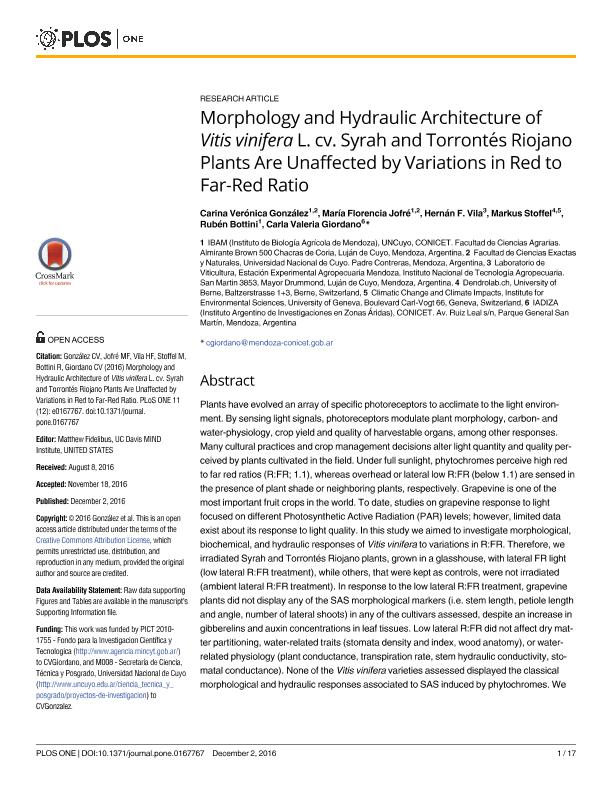Artículo
Morphology and hydraulic architecture of vitis vinifera L. cv. syrah and torrontés riojano plants are unaffected by variations in red to far-red ratio
Gonzalez, Carina Veronica ; Jofré, María Florencia; Vila, Hernán Félix; Stoffel, Markus; Bottini, Ambrosio Rubén
; Jofré, María Florencia; Vila, Hernán Félix; Stoffel, Markus; Bottini, Ambrosio Rubén ; Giordano, Carla Valeria
; Giordano, Carla Valeria
 ; Jofré, María Florencia; Vila, Hernán Félix; Stoffel, Markus; Bottini, Ambrosio Rubén
; Jofré, María Florencia; Vila, Hernán Félix; Stoffel, Markus; Bottini, Ambrosio Rubén ; Giordano, Carla Valeria
; Giordano, Carla Valeria
Fecha de publicación:
12/2016
Editorial:
Public Library of Science
Revista:
Plos One
ISSN:
1932-6203
Idioma:
Inglés
Tipo de recurso:
Artículo publicado
Clasificación temática:
Resumen
Plants have evolved an array of specific photoreceptors to acclimate to the light environment. By sensing light signals, photoreceptors modulate plant morphology, carbon- and water-physiology, crop yield and quality of harvestable organs, among other responses. Many cultural practices and crop management decisions alter light quantity and quality perceived by plants cultivated in the field. Under full sunlight, phytochromes perceive high red to far red ratios (R:FR; 1.1), whereas overhead or lateral low R:FR (below 1.1) are sensed in the presence of plant shade or neighboring plants, respectively. Grapevine is one of the most important fruit crops in the world. To date, studies on grapevine response to light focused on different Photosynthetic Active Radiation (PAR) levels; however, limited data exist about its response to light quality. In this study we aimed to investigate morphological, biochemical, and hydraulic responses of Vitis vinifera to variations in R:FR. Therefore, we irradiated Syrah and Torrontés Riojano plants, grown in a glasshouse, with lateral FR light (low lateral R:FR treatment), while others, that were kept as controls, were not irradiated (ambient lateral R:FR treatment). In response to the low lateral R:FR treatment, grapevine plants did not display any of the SAS morphological markers (i.e. stem length, petiole length and angle, number of lateral shoots) in any of the cultivars assessed, despite an increase in gibberelins and auxin concentrations in leaf tissues. Low lateral R:FR did not affect dry matter partitioning, water-related traits (stomata density and index, wood anatomy), or waterrelated physiology (plant conductance, transpiration rate, stem hydraulic conductivity, stomatal conductance). None of the Vitis vinifera varieties assessed displayed the classical morphological and hydraulic responses associated to SAS induced by phytochromes. We discuss these results in the context of natural grapevine environment and agronomical relevance. Copyright:
Palabras clave:
Vitis Vinifera
,
Phytochorme
Archivos asociados
Licencia
Identificadores
Colecciones
Articulos(IADIZA)
Articulos de INST. ARG DE INVEST. DE LAS ZONAS ARIDAS
Articulos de INST. ARG DE INVEST. DE LAS ZONAS ARIDAS
Articulos(IBAM)
Articulos de INST.DE BIOLOGIA AGRICOLA DE MENDOZA
Articulos de INST.DE BIOLOGIA AGRICOLA DE MENDOZA
Citación
Gonzalez, Carina Veronica; Jofré, María Florencia; Vila, Hernán Félix; Stoffel, Markus; Bottini, Ambrosio Rubén; et al.; Morphology and hydraulic architecture of vitis vinifera L. cv. syrah and torrontés riojano plants are unaffected by variations in red to far-red ratio; Public Library of Science; Plos One; 11; 12; 12-2016; 1-17; e0167767
Compartir
Altmétricas



